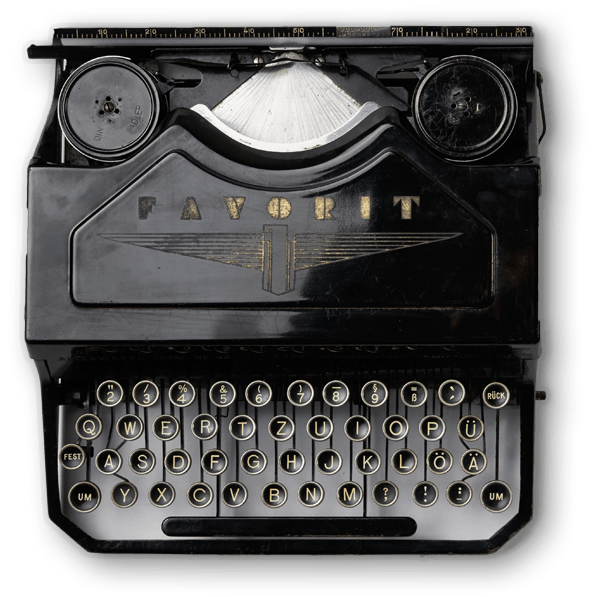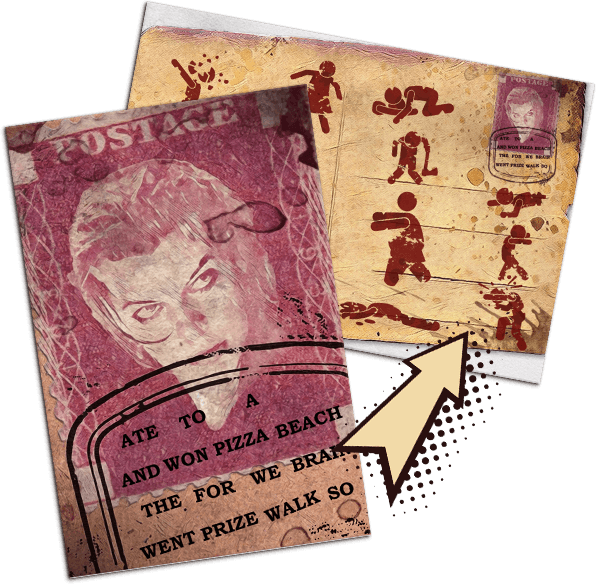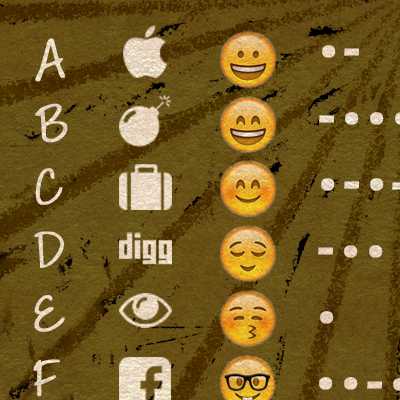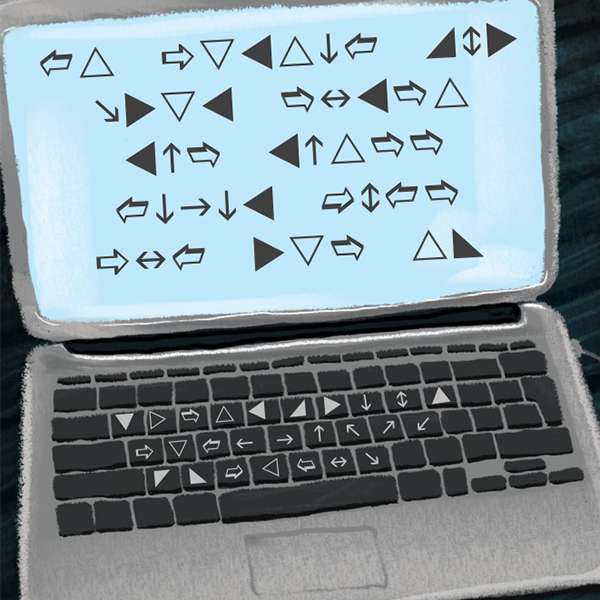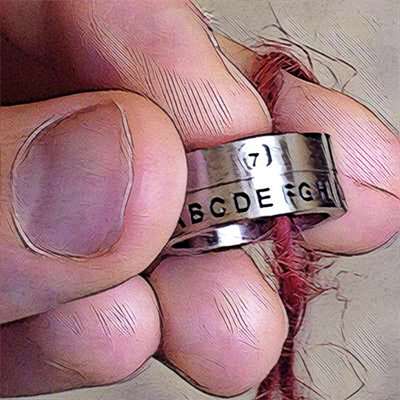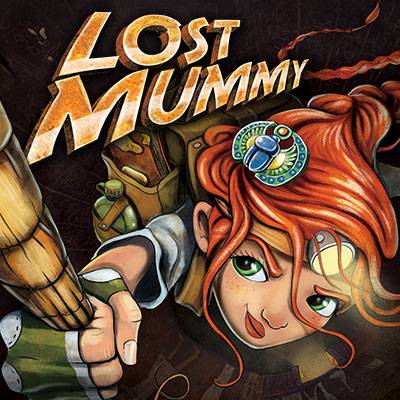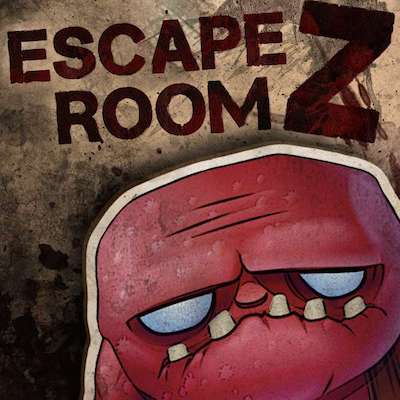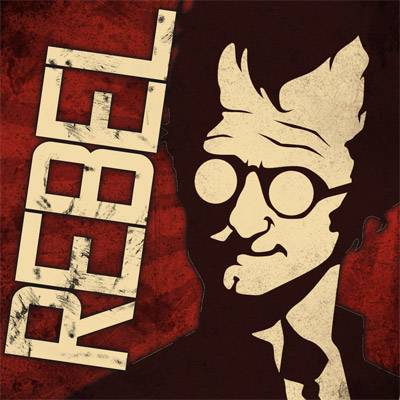'Crack the Rule' Ciphers
Rule-based ciphers are generally the best for escape rooms.
They're creative, easy to design, and are unique so players get the maximum 'we solved it' feeling. Try one of these ciphers, pulled straight from the ancient scrolls of wisdom:
This 'mess it all up' cipher is from the Escape Room Z game kit and requires 3 separate clues to sort.
The 'Mess it all up' Cipher
These are the best ciphers for escape rooms.
They're fun to solve, avoid frustration, easy to make, and anyone can do them without prior knowledge.
To make one, jumble a sentence like in the stamp pic. Then leave players a clue for how to unscramble it. In this example, the stamp connects to a postcard with a field of zombies in the same configuration as the words, which in turn connects to another card that shows the sequence. (this one's part of the Escape Room Z printable kit).
You can leave any clue that shows a sequence:
- An acrostic where the first letter of each word matches the sentence. You'll need to ensure there are no double ups in the original phrase for this.
- Color code the words and match this to a color pattern somewhere else.
- A sequence of numbers which matches the number of letters in each word. Again, this requires the sentence to have words of different lengths.
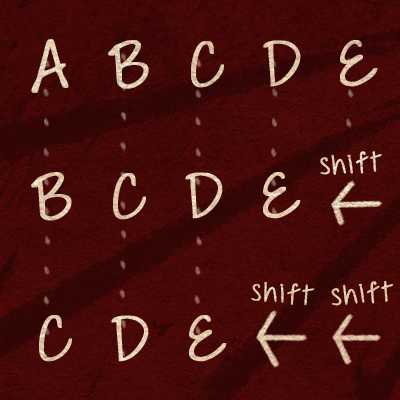
Letter shifting (Caesar Cipher)
Caeser Ciphers are one of the easiest ciphers to make and are really engaging in an escape party. Start by writing out the alphabet A-Z. Next write it out again underneath but shift the start to another letter like J. The amount that you move the second set of characters is called the shift or key.
Here's an example that encodes Escape Party into ciphertext using shift 2. You can make it yourself using pen and paper or this tool.

Once you've got your message it's dead easy to slip it into your escape room. Simply put both the ciphertext and shift in plain sight. This works great because both are meaningless until combined.
Take it to the next level by using something else to represent the shift like:
- Circling the number 2 on the clock in your living room.
- Write the ciphertext on a piece of paper cut into a triangle.
- Put the message in an envelope and make the house address the shift (go over it a few times to highlight it).
Two great mods of the Caeser Cipher are the AtBash Code where you reverse the alphabet (so A=Z, B=Y, C=X etc...) or replacing each letter with a number (A=1, B=2, C=3 etc...).
Whatever you choose you've probably worked out that players could easily 'go orc' on this thing and just brute force hack a Caesar cipher using trial and error. That's totally ok as it's still a challenge! It simply means that you probably want to create something harder for the Master Challenge in your escape room like a Vigenere cipher.
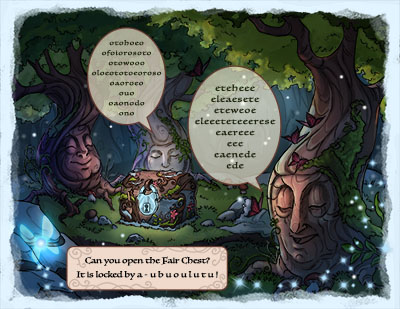
This puzzle from our Frost kit is perfect for kids
This kit is for casual players so the cipher needed to be nice and simple.
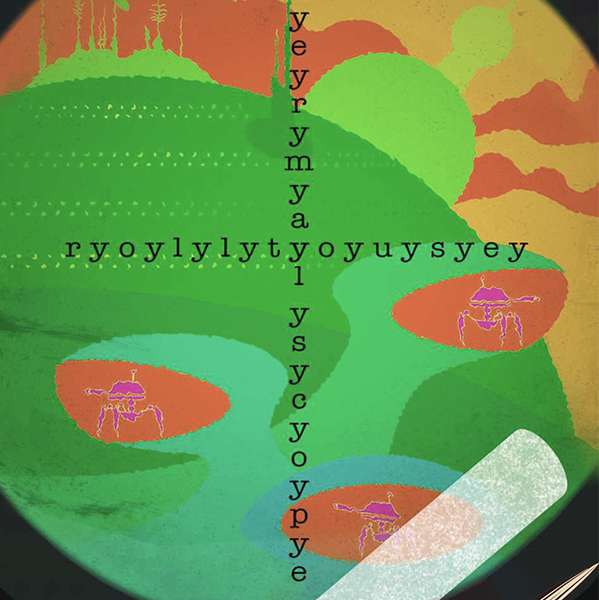
Swapped Letter Rules
These are fun to make and thrilling to solve, which makes them perfect as a warm-up puzzle in your escape room.
You find a rule to follow and apply it to your text. For example:
- The first letter of each word in a sentence (TFLOEWIAS - as you can see you'll need to do some wordsmithing).
- Swap two letters in random words which get combined to make a phrase. Lexi and Pyko, from EscapeRoomReviews.org, designed an awesome one for a resume.
- Follow a number sequence like 2, 4, 6, 8, which you can give to players as a clue. In this sentence, that would be OWECWIAC (again, you'll need to do some wordsmithing)
- Add extra letters into the sequence. Fyoyr yeyxyaymypylyey.
There are endless combinations which allow you to include several in the one escape room game. For example, use an easy version for one of the 1st puzzles and a harder, but similar, one towards the end. This gives players a sense of learning and progression which are major parts of what makes solving puzzles fun.
Swapping Symbols
You're very familiar with this type of cipher. It's the classic A=1, B=2, C=3 code you did at school. Or a book code where a sequence of numbers corresponds to the words on a page
But, you can make something much cooler than that.
After all, this is your 1st escape room and it's going to be stylish. Try one of these instead:
Symbol Swapping
The Caesar Cipher is simple to make and decode in an escape room. However, it limits creativity because the algorithmic approach always produces a sequence of numbers.
A more interesting option is to do a straight character for character, or word for word, swap. Effectively you're making a whole alphabet.
Try one of these on for size:
- Morse code: those beepy machines in war movies. When you write it down like a superspy, it looks like:
•••• • •• •••- | -•-• •-• • •-- - PigPen cipher: replaces each letter in your message with a symbol from a set of special punnet squares. Here's a cool tool to check it out
- Symbol font: open up Word and choose a new font like Symbol or Wingdings. You can then just write out your message in normal English and it will look like Ciphertext. This is great, sneaky puzzle for an escape room because you can give players the key by writing the name of the font on one of the clues.
- Font Awesome: has a bunch of icons you can use that can represent each letter. For example A=Apple, B=Bomb, C=Case. Use Fontello to create your DIY font.
- Phone emoticons: since everyone has the same set of emoticons in their SMS app you can actually make an alphabet out of them. Your key becomes either 'Android' or 'Apple' and the ciphertext is just a screenshot from your phone of the SMS. All a player has to do is make the logical connection, get their phone out, and decypher the message. But be prepared with a backup plan if the tech goblins decide to mess up at the worst possible moment!
- Decoder ring: these are a super fun decryption device you can pick up pretty cheap on Amazon and reuse in every escape game you design.
- Color code: use different colored shapes to create your own cipher. There's 7 colors so all you need is to choose 6 different shapes and you've got the whole alphabet and numbers covered.
- Keyboard code: since computer keyboards are all the same they can be used as the key to make a ridiculously challenging code for your escape game. Just grab one from around the house and encode your message using Q=1, W=2, E=3 etc...
- Language code: Use Google Translate to convert your message into German or French. On the night give the players a pocket translation book or let them use Google.

Book code (hard)
Book codes are caked in so much old-school awesomeness they're practically moldy! The resulting ciphertext just looks like a random miss-match of numbers and without the original text is unbreakable! All you have to do is replace each word in your message with the number that corresponds to that position in your book.
How To Make Your Own Book Code:
- Grab an old book or newspaper. You can download a customizeable template in the Rebel Revolt kit.
- Find the first word of your message somewhere on the first few pages
- Count how many words it is from the beginning of the book and write that down as the first part of your ciphertext. Alternatively use pairs of numbers like <page number>.<word number>.
- Keep going until your message is complete.
- You'll need to leave a clue to help the Heist Crew decode your Book Code. For example, scribble the numbers under a few of the words in the book to tip the game players off.
- Put the book somewhere visible or ready for the Escape game to begin.
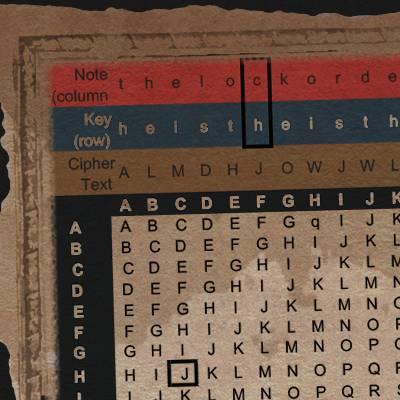
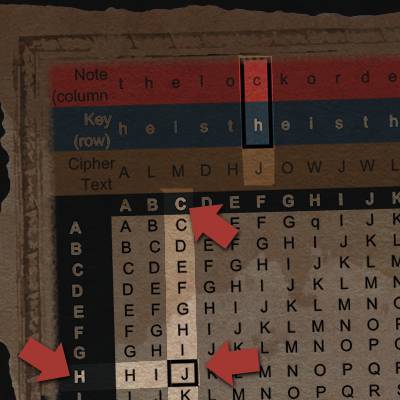
Vigenere / Grid Code
This code's a perfectly boss-level puzzle for the Master Challenge in your escape room. It's not easy to understand, but your crew will never forget cracking it.
We're going to use a grid of 26 different Caesar Ciphers and look up XY coordinates on that grid to encode our text. It's kind of like playing that board game Battleships where you destroy your opponents ships by guessing X and Y coordinates.
How To Encode Your Message:
- Open the Vigenere Square template.
- Enter your plaintext message in the top row. Each letter here is the column to check the table for (X coordinate).
- Choose a Keyword and enter it in the 2nd row (just repeat until the whole row is full). Each letter here is the row to check the table for (Y coordinate).
- Make your ciphertext by taking the first letter of your message and highlighting that column. Then get the first letter of the keyword and highlight that row. Whichever letter is at the intersection is the first character in the ciphertext.
How To Design It Into Your Escape Room Game:
Since this is a mega hard code, you'll need to give players some solid clues for how to solve it. After all, it's an escape game not international espionage!
- The Vigenere Square template has sections labeled Key and Message to give players a head start.
- Embed the keyword somewhere into the puzzle. For example, a hidden message written in invisible ink or the result of solving an earlier puzzle.
- Give a hint that this is a coordinate based problem by writing the first few message-key combinates in a way that people are familiar with like:
- A list of coordinates for a game of battleships.
- List of moves in chess. This stands out because there's obviously no RV square on a chess board.
- A map with a series of directions that don't make sense but show a 'Grid lookup' strategy.
This cipher's no walk in the park but makes for a riveting super-challenge for an experienced Heist Crew!
Hidden in plain sight
These are only solvable if players look at the problem the right way.
If they do, they get an amazing 'aha' moment.
If not, they'll get nothing (ok, if you're a nice game master, maybe they'll get a hint).
For example, each misspelled word in a paragraph might combine to form a message. Alternatively, swap 2 characters in particular words.
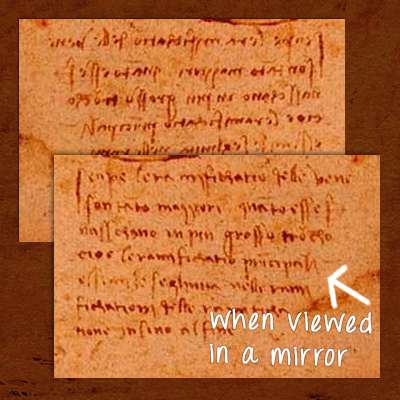
Mirror Writing
This one's super simple but a lot of fun. Write your message backwards using the Reverse feature of this tool.
It's not a particularly hard puzzle to solve so unless your escape game is for young kids don't leave any hints that the players need to use a mirror.
As a side note: building a mirror into your escape room is also a really good way to discover any vampires that may be hiding in your party (because, let's face it, throwing garlic at people isn't socially acceptable!).
Score a magical Escape Room Kit:
Haven't found something you love? Just grab whichever one of these printable escape room kits you like the feel of the most.
They download instantly and are ready to print & party.
You can even edit the game, using PowerPoint, to add your own style and puzzles.
